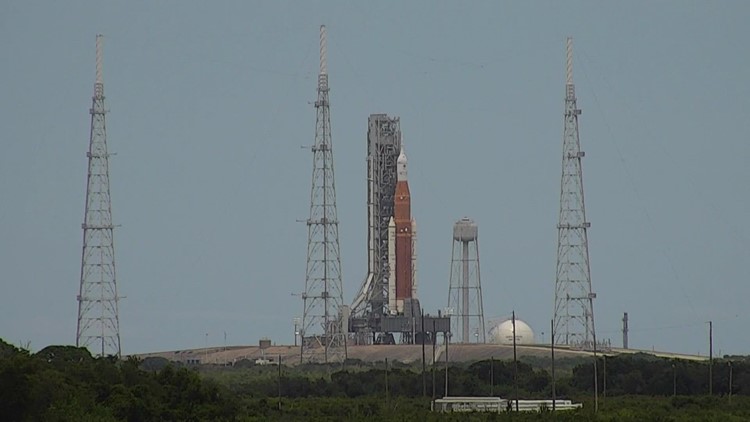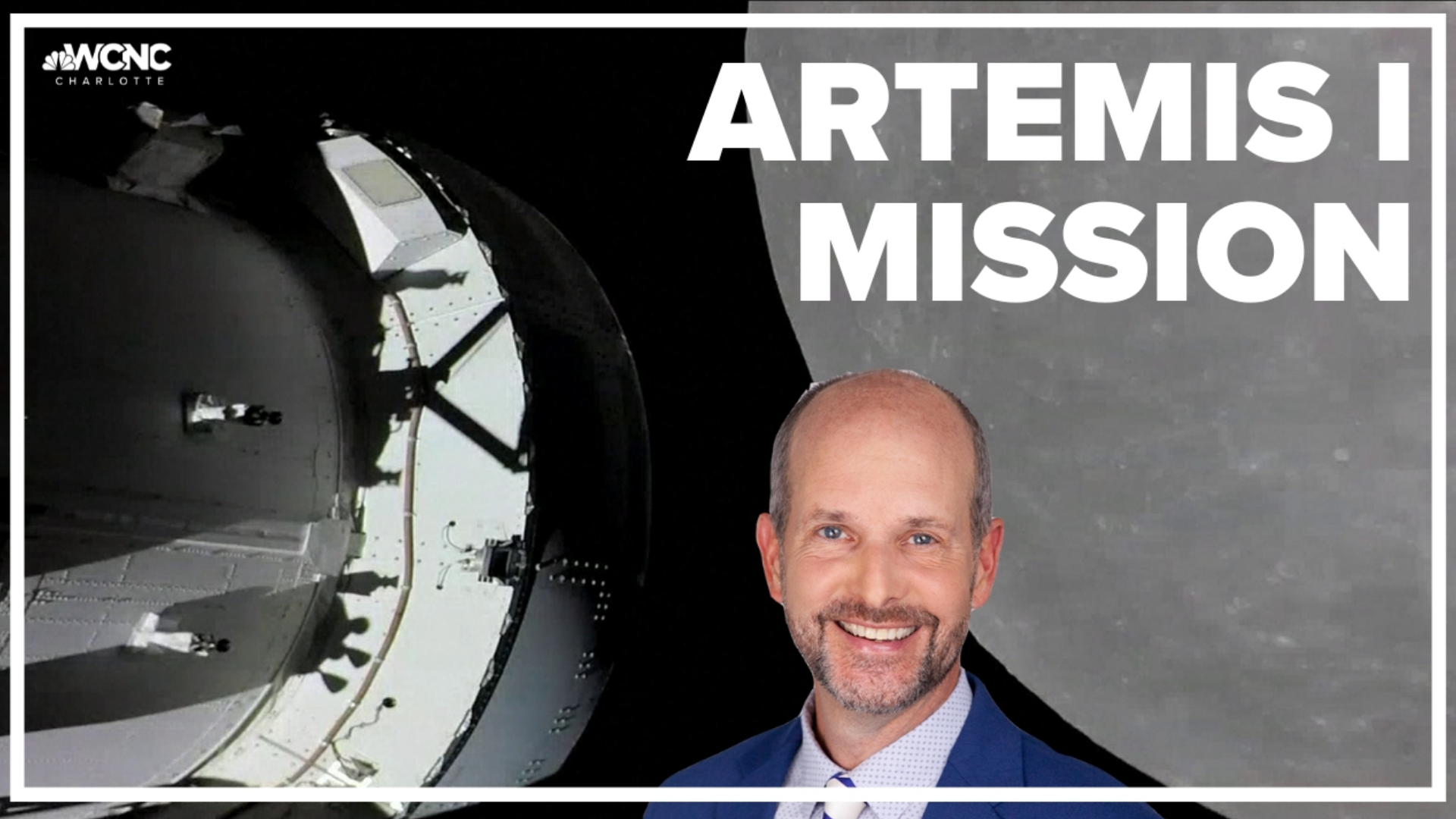CAPE CANAVERAL, Fla. — After months of delays, NASA will once again try to launch Artemis-1, the first in a series of missions set to return humans to the Moon.
After a fuel leak prompted a scrub of the first two launch attempts on Aug. 29 and Sept. 3, Hurricane Ian and Hurricane Nicole caused NASA to postpone launch attempts.
At 1:04 a.m. ET Wednesday, NASA hopes to open a two-hour launch window that could see the rocket finally liftoff from Florida's Kennedy Space Center.
The mission comes 50 years after NASA's famed Apollo moonshot.
HOW TO WATCH THE ARTEMIS LAUNCH
The two-hour launch window opens at 1:04 a.m. ET Wednesday.
WCNC Charlotte Chief Meteorologist Brad Panovich and WKYC 3 Studios Chief Meteorologist Betsy Kling will host live streaming coverage of the Artemis-1 launch.
You can stream Brad's coverage on WCNC+, available for free on the WCNC Charlotte apps for Roku, Amazon Fire, iPhone, and Android. WCNC+ also streams on wcnc.com. Coverage will also stream on the WCNC Charlotte Weather IQ YouTube channel.
RISKY AND EXPENSIVE
The price tag for this single mission exceeds $4 billion. The entire program will have set NASA back $93 billion by the time astronauts are back on the moon.
If all goes well with the launch, astronauts could strap in as soon as 2024.
The six-week test flight is risky and could be cut short if something fails, NASA officials warn.
“We’re going to stress it and test it. We’re going make it do things that we would never do with a crew on it in order to try to make it as safe as possible,” NASA Administrator Bill Nelson told The Associated Press on Wednesday.
Here’s a rundown of the first flight of the Artemis program, named after Apollo’s mythological twin sister.
ROCKET POWER
The new rocket is shorter and slimmer than the Saturn V rockets that hurled 24 Apollo astronauts to the moon a half-century ago. But it’s mightier, packing 8.8 million pounds (4 million kilograms) of thrust. It's called the Space Launch System rocket, SLS for short, but a less clunky name is under discussion, according to Nelson. Unlike the streamlined Saturn V, the new rocket has a pair of strap-on boosters refashioned from NASA’s space shuttles. The boosters will peel away after two minutes, just like the shuttle boosters did, but won’t be fished from the Atlantic for reuse. The core stage will keep firing before separating and crashing into the Pacific in pieces. Two hours after liftoff, an upper stage will send the capsule, Orion, racing toward the moon.
MOONSHIP
NASA's high-tech, automated Orion capsule is named after the constellation, among the night sky’s brightest. At 11 feet (3 meters) tall, it's roomier than Apollo's capsule, seating four astronauts instead of three. For this test flight, a full-size dummy in an orange flight suit will occupy the commander’s seat, rigged with vibration and acceleration sensors. Two other mannequins made of material simulating human tissue — heads and female torsos, but no limbs — will measure cosmic radiation, one of the biggest risks of spaceflight. One torso is testing a protective vest from Israel. Unlike the rocket, Orion has launched before, making two laps around Earth in 2014. This time, the European Space Agency's service module will be attached for propulsion and solar power via four wings.
FLIGHT PLAN
Orion’s flight is supposed to last six weeks from its Florida liftoff to Pacific splashdown, twice as long as astronaut trips in order to tax the systems. It will take nearly a week to reach the moon, 240,000 miles (386,000 kilometers) away. After whipping closely around the moon, the capsule will enter a distant orbit with a far point of 38,000 miles (61,000 kilometers). That will put Orion 280,000 miles (450,000 kilometers) from Earth, farther than Apollo. The big test comes at mission’s end, as Orion hits the atmosphere at 25,000 mph (40,000 kph) on its way to a splashdown in the Pacific. The heat shield uses the same material as the Apollo capsules to withstand reentry temperatures of 5,000 degrees Fahrenheit (2,750 degrees Celsius). But the advanced design anticipates the faster, hotter returns by future Mars crews.
HITCHHIKERS
Besides three test dummies, the flight has a slew of stowaways for deep space research. Ten shoebox-size satellites will pop off once Orion is hurtling toward the moon. The problem is these so-called CubeSats were installed in the rocket a year ago, and the batteries for half of them couldn’t be recharged as the launch kept getting delayed. NASA expects some to fail, given the low-cost, high-risk nature of these mini satellites. The radiation-measuring CubeSats should be OK. Also in the clear: a solar sail demo targeting an asteroid. In a back-to-the-future salute, Orion will carry a few slivers of moon rocks collected by Apollo 11's Neil Armstrong and Buzz Aldrin in 1969, and a bolt from one of their rocket engines, salvaged from the sea a decade ago. Aldrin isn't attending the launch, according to NASA, but three of his former colleagues will be there: Apollo 7's Walter Cunningham, Apollo 10's Tom Stafford and Apollo 17's Harrison Schmitt, the next-to-last man to walk on the moon.
APOLLO VS. ARTEMIS
More than 50 years later, Apollo still stands as NASA’s greatest achievement. Using 1960s technology, NASA took just eight years to go from launching its first astronaut, Alan Shepard, and landing Armstrong and Aldrin on the moon. By contrast, Artemis already has dragged on for more than a decade, despite building on the short-lived moon exploration program Constellation. Twelve Apollo astronauts walked on the moon from 1969 through 1972, staying no longer than three days at a time. For Artemis, NASA will be drawing from a diverse astronaut pool currently numbering 42 and is extending the time crews will spend on the moon to at least a week. The goal is to create a long-term lunar presence that will grease the skids for sending people to Mars. NASA's Nelson, promises to announce the first Artemis moon crews once Orion is back on Earth.
WHAT'S NEXT
There's a lot more to be done before astronauts step on the moon again. A second test flight will send four astronauts around the moon and back, perhaps as early as 2024. A year or so later, NASA aims to send another four up, with two of them touching down at the lunar south pole. Orion doesn’t come with its own lunar lander like the Apollo spacecraft did, so NASA has hired Elon Musk's SpaceX to provide its Starship spacecraft for the first Artemis moon landing. Two other private companies are developing moonwalking suits. The sci-fi-looking Starship would link up with Orion at the moon and take a pair of astronauts to the surface and back to the capsule for the ride home. So far, Starship has only soared six miles (10 kilometers). Musk wants to launch Starship around Earth on SpaceX's Super Heavy Booster before attempting a moon landing without a crew. One hitch: Starship will need a fill-up at an Earth-orbiting fuel depot, before heading to the moon.




